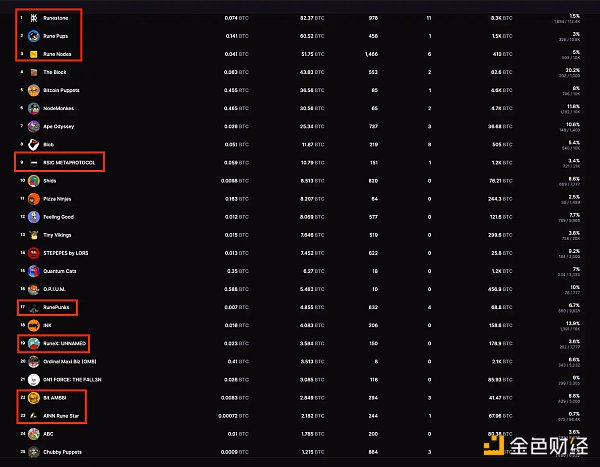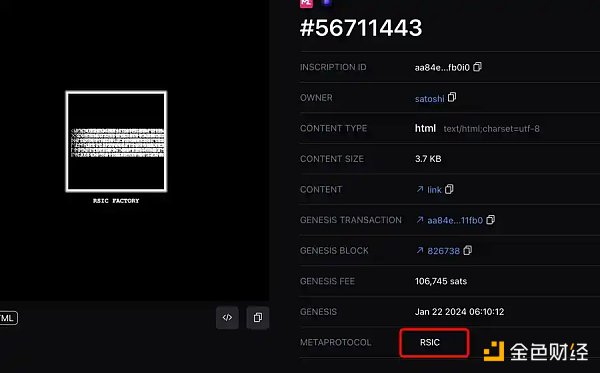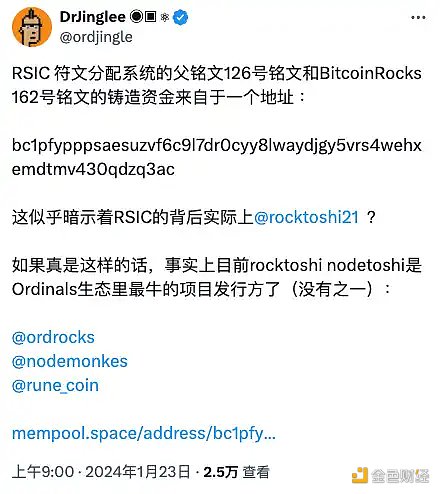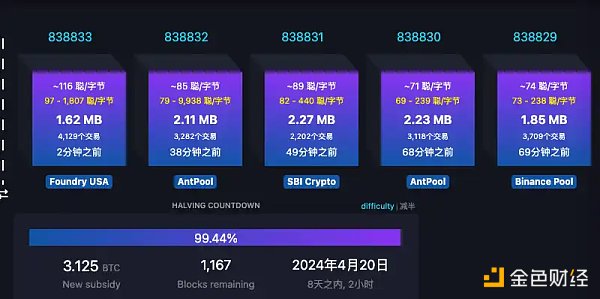Author: Jaleel; Source: BlockBeats
Bitcoin halving is approaching, and another group of people are making money.
With only more than a thousand blocks left before Bitcoin halving, the Bitcoin ecosystem in April has undoubtedly become the focus of the market. Among them, the hottest topic is the concept of Runes, especially Runestone, which has a market value of US$640 million, which has caused its floor price to soar to 0.074BTC, surpassing BAYC and becoming the second largest project in the NFT market.
Not only Runestone, but also on the magiceden market, 8 of the top 25 NFTs with the largest trading volume are Runes. Since April, the trading volume of NFTs in the Bitcoin ecosystem has significantly exceeded that of Ethereum and Solana, among which Runes-based NFTs account for the largest proportion.

Behind these trading volumes are these "preemptive" Runes projects, which are like "mining machines". After the halving time, the number of airdropped Runes tokens will be calculated based on the holding time and the number of holdings.
RSIC is one of the earliest projects with "mining machine" attributes, and it has been more than two months since its tokens were airdropped to the wallet. There is still about a week before the Bitcoin halving is completed. How much money can early layouters expect to make two months ago?
Because Runestone has not yet announced the specific airdrop details, and RSIC, which has more detailed airdrop rules, has already had a trading market on the OTC platform whales.market, it is easier to calculate the income. Therefore, the following article mainly uses RSIC to calculate and discuss "How much money can the earliest users who participated in the Runes pre-mining expect to make?"
Income forecast: Taking RSIC as an example
Before calculating the income, BlockBeats first gives a brief introduction to the RSIC project for new users.
RSIC is a peer-to-peer rune distribution system based on Bitcoin, and its core is built as a digital interactive game. On this platform, players obtain runes by managing and operating RSIC tokens, and these runes are expected to be officially "engraved" on the Bitcoin network at some point in the future. Currently, the trading price of RSIC is 0.06 BTC. Regarding RSIC Metaprotocol, the total number of NFTs issued is 21,000, and the total issuance of FTs (tokens) is about 21 billion, of which the project party retains 10% of the NFT share.

In addition, when it comes to RSIC, one of the most frequently discussed topics is the mysterious issuer of this project. Initially, there were rumors that this might be the work of Casey, the founder of ordinals, but as Casey was deeply involved in the game world of Baldur's Gate 3, this speculation was quickly refuted. The more widely accepted view at present is that RSIC may have been deployed by Rocktoshi, the founder of Node Monkey, based on the fact that the minting funds of all parent inscriptions come from the same address. For details, see Dr. Jin Gou's related analysis on Twitter.

The trick to maximize your profits
RSIC's token airdrop rules are very clear, with 4 variables.
The first variable is "Flat": This variable involves the number of blocks held, stipulating that each block can get 21 RSIC tokens, and the total does not exceed 30% of all airdrops.
The second variable is "Boosted": Users who hold Boost accelerators can get double mining efficiency, which is the relevant boost logic easter egg engraved on 4703400000000 Satoshi.

The third variable is "Random allocation": 25% of the total airdrop plus the unallocated Flat and Boost parts. Each RSIC corresponds to a specific type code symbol. When the last digit of the block hash value of a block is consistent with the user's RSIC symbol, the user can get 336 RS tokens. Considering the 16 possibilities of the last digit of the hash value, theoretically there is a chance of success every 16 blocks, which is equivalent to an average of 21 tokens per block.
The fourth variable is the "Halfening Lottery": At the specific halving block 840,000, the project will randomly select 5 addresses holding RSIC Metaprotocol NFTs and distribute 15% of the total tokens (the distribution ratio is 5%, 4%, 3%, 2% and 1%). Users who hold from block 830,000 to block 840,000 will receive one lottery ticket for each block they hold; if they sell before the halving, they will lose the lottery qualification.
Users who hold both RSIC and Boost are expected to mine a total of 63 tokens per block, and users who only hold RSIC are expected to mine a total of 42 tokens per block. It is worth mentioning that even if you have sold RSIC, the quota you accumulated during the holding period is still recorded on your wallet address.
In addition, it should be noted that only RSIC addresses that have been activated are eligible to receive airdrops. Any RSIC that has been transferred or traded on the market is considered activated. This operation is designed to ensure that only active wallets can participate in the distribution of tokens, thereby excluding any dormant wallets and ensuring the fairness and activity of the airdrop.
Easily make $10,000 before halving
Currently, it can be seen that on the OTC platform whales.market, the buyer price of RSIC rune tokens is mainly concentrated at 0.01u, corresponding to a total market value of $210 million. Recent transaction records show that the highest unit prices are $0.025, $0.0349, and $0.0374, respectively, corresponding to market values of $500 million, $730 million, and $780 million, respectively, which is close to Runestone's $640 million market value.
However, compared with the continued rise of Runestone, RSIC's NFT market shows a downward trend. Optimistically, compared with the highest price of 0.13BTC, RSIC's market value has decreased, but in fact part of its value and market value are more reflected in the token.
According to BlockBeats' analysis, the current price of buying an RSIC at 0.06BTC and paying an additional 0.005btc to buy a boost accelerator costs about $4,700. As of the time of writing, there are still 1,167 blocks to be halved, and it is expected that each block can obtain 63 tokens, a total of 73,521 tokens, which means that the cost of the token at the time of halving is about $0.0639. This price is much higher than the over-the-counter price of whales.market.
If you don’t consider the value of RSIC after the airdrop of Runes tokens, and only consider the cost and price of obtaining tokens, it is obviously a more appropriate choice to buy points directly from the over-the-counter market now.

According to information BlockBeast learned from early users, the price of RSIC when it was first launched on the magiceden market was 0.02BTC. At that time, if you bought one RSIC and held it until the halving period, you are expected to get 520,000 points without using boost. Calculated at a conservative price of $0.01, the profit is about $5,200, plus the value growth of RSIC itself, that is, the purchase price of 0.02BTC can bring an additional profit of 0.04BTC, equivalent to $2,800. Combined with the airdrops of other projects such as Rune Mania Mine to RSIC Boost holders, the conservative comprehensive profit is estimated to be about $10,000. If you hold boost, the points are expected to reach 700,000, and the corresponding profit is expected to be about $13,000.
From a non-conservative perspective, if RSIC is obtained entirely through airdrops, it is equivalent to directly obtaining an NFT worth 0.06BTC, with a profit of about $4,260. Assuming that 700,000 points are calculated at a price of $0.035, the profit is $24,500. Add to that the $2,000 profit from airdrops from other projects, and the total profit is about $30,000.
In the short term, the halving of Bitcoin and the official launch of Runes may trigger strong emotions (FOMO) in the market. From a longer-term perspective, as Casey issues tokens specifically for the community, the Runes protocol may have as much influence as Ordinals. The market value of the leader of the Runes protocol may be comparable to that of the leader of brc20, and may even have a certain impact on it.
Combined with the current market situation, Ordi's market value is $1.5 billion, Sats is $990 million, and Runestone's current market value is $640 million. It can be inferred that users who participated in the Runes pre-mining in the early stage may still have some room for profit growth.
 JinseFinance
JinseFinance
 JinseFinance
JinseFinance JinseFinance
JinseFinance Huang Bo
Huang Bo YouQuan
YouQuan Cheng Yuan
Cheng Yuan dailyhodl
dailyhodl Coindesk
Coindesk Cointelegraph
Cointelegraph Cointelegraph
Cointelegraph Cointelegraph
Cointelegraph